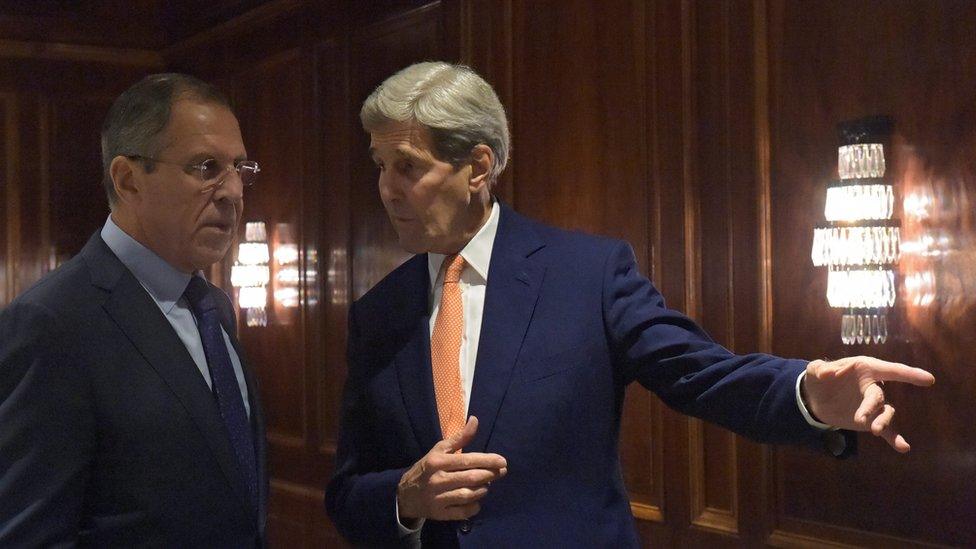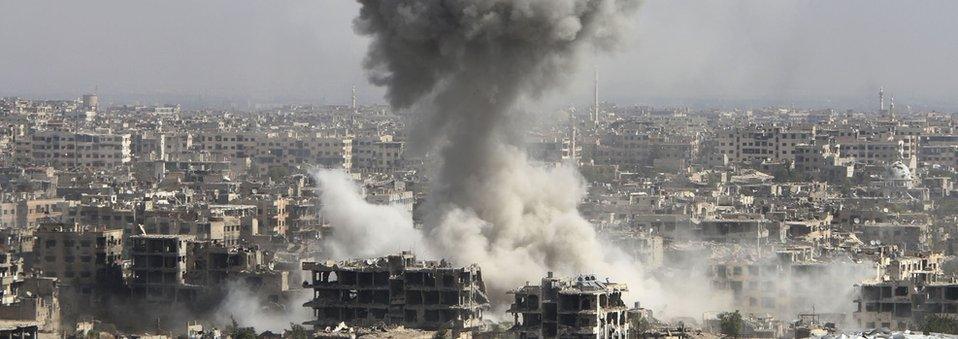Syria war: Lavrov seeks talks with 'full spectrum' of opposition
- Published

Russia and the US back opposing sides in Syria's war
Syria's ally Russia says there should be talks between the Syrian government and the "full spectrum" of opposition.
Foreign Minister Sergei Lavrov also urged an intensification of efforts to find a political solution to the war.
Mr Lavrov was speaking after meeting his counterparts from Saudi Arabia, Turkey and the US.
On Thursday, President Putin suggested the Syrian regime could be ready to work with some rebel groups against the so-called Islamic State.
Mr Putin said President Assad had agreed to the idea on a recent visit to Moscow,
Speaking at the start of talks in Vienna on Friday, Mr Lavrov said: "Our common position is that we need to boost efforts for the political process in the Syrian settlement.
Abdel Aziz Abu Hamad Aluwaisheg, member of Gulf Cooperation Council: [Russian intervention] "best gift to terrorists"
"This foresees the start of full-scale talks between representatives of the Syrian government and the full spectrum of the Syrian opposition, both domestic and external - with the support of outside players."
Mr Lavrov did not define exactly which opposition groups should be included.

Russia insists it wants to save Syria from "terrorists", not prop up Mr Assad
US Secretary of State John Kerry, who also attended, said the talks had been "constructive" and that an expanded round of negotiations could take place next week.
The US, Turkey and Saudi Arabia all support rebel groups fighting the Syrian government. Russia backs President Assad and hosted him on Tuesday in a visit criticised by the US.
Russia has been bombing targets in Syria since last month. It says it is primarily hitting IS, but Western powers say most of the air strikes have hit rebel groups, including those backed by the West and Gulf states.
'Successful offensive'
However, Vladimir Putin's spokesman said on the BBC's HARDtalk programme that Russia's intervention in Syria was not an attempt to prop up President Assad but rather an attempt to save the country and the region from falling under the sway of terrorists.
Dmitry Peskov said a political settlement was impossible without dialogue with the "legitimate president" of Syria.
Vladimir Putin's spokesman, Dmitry Peskov: Russian forces trying to "save Syria from terrorists"
And he echoed Mr Putin's speech at the Valdai discussion forum by saying all the "serious" rebel forces in Syria were "terrorists".
Mr Peskov said the West had so far failed to identify any "balanced opposition" to Mr Assad that did not have links to jihadists.
The US-led air campaign against the so-called Islamic State had led to IS controlling two-thirds of the country's territory, Mr Peskov argued, but there were now signs the Syrian army - backed by Russian air strikes - was mounting a successful offensive against rebels.
Mr Peskov also said Russia wanted to exchange military information with the US, including about targets of air strikes, but this had not been forthcoming.

Controversial weapon - Jonathan Marcus, BBC diplomatic and defence correspondent
YouTube video from the fighting in Syria has thrown up images of a rarely seen Russian weapons system, external - the TOS-1 "Buratino" multiple rocket launcher.
Described by the Russians as a "heavy flame-thrower", it is a highly controversial weapon and its appearance in Syria raises the question as to who is actually operating it.
The TOS-1 fires a 220mm rocket that is designed to carry a thermobaric warhead. Sometimes known as a "fuel-air explosive" the rockets detonates at a set altitude above the ground, releasing a cloud of fuel which is then ignited by a second explosion.
This creates a huge temperature and pressure wave whose impact has been likened to a low-yield nuclear explosive.
It is very much an indiscriminate weapon, typically used to support offensive operations by blanketing given areas with fire. Thermobaric weapons were used to devastating effect by the Russians in Afghanistan.



Why is there a war in Syria?
Anti-government protests developed into a civil war that, four years on, has ground to a stalemate, with the Assad government, Islamic State, an array of Syrian rebels and Kurdish fighters all holding territory.
Who is fighting whom?
Government forces concentrated in Damascus and the centre and west of Syria are fighting the jihadists of Islamic State and Jabhat al-Nusra, as well as less numerous so-called "moderate" rebel groups, who are strongest in the north and east. These groups are also battling each other.
What's the human cost?
More than 250,000 Syrians have been killed and a million injured. Some 11 million others have been forced from their homes, of whom four million have fled abroad - including growing numbers who are making the dangerous journey to Europe.
How has the world reacted?
Iran, Russia and Lebanon's Hezbollah movement are propping up the Alawite-led Assad government, while Turkey, Saudi Arabia and Qatar back the more moderate Sunni-dominated opposition, along with the US, UK and France. Hezbollah and Iran are believed to have troops and officers on the ground, while a Western-led coalition and Russia are carrying out air strikes.